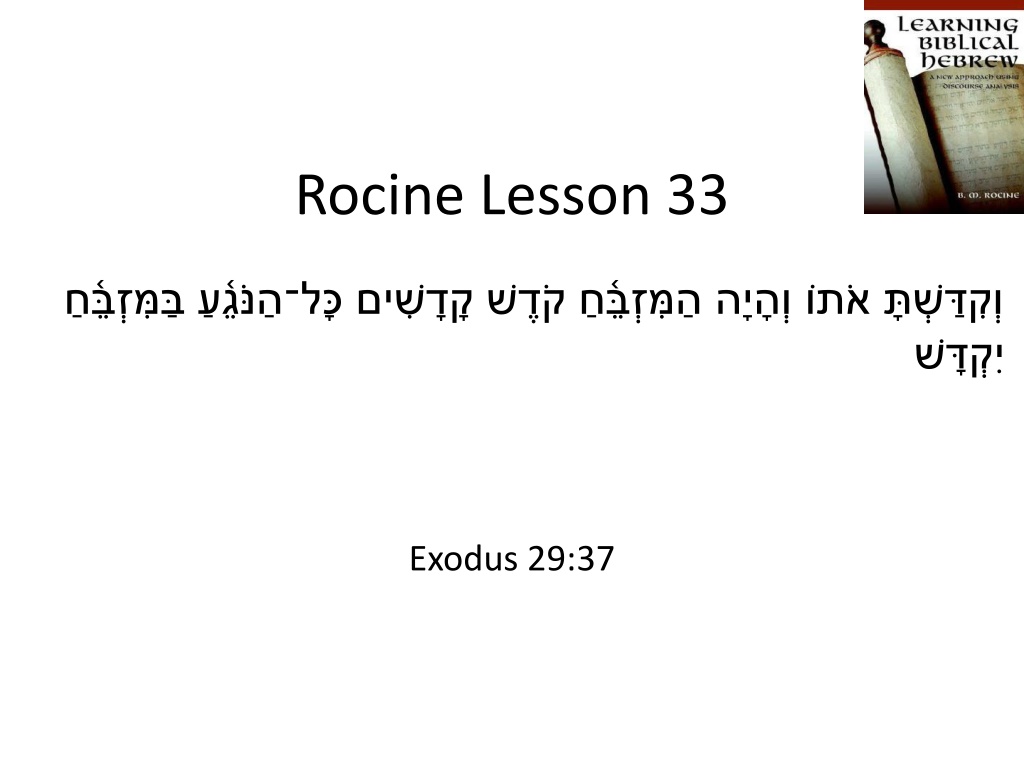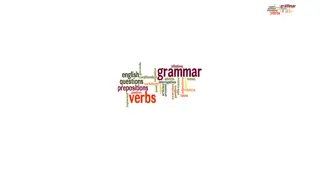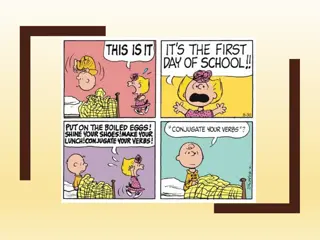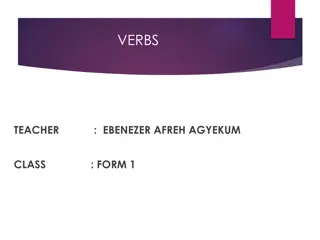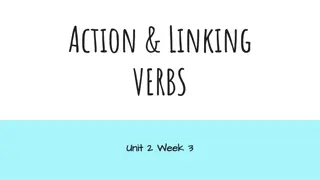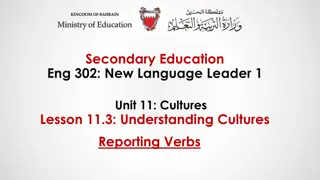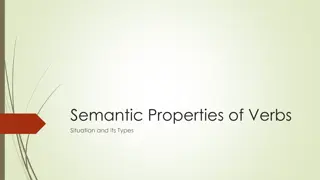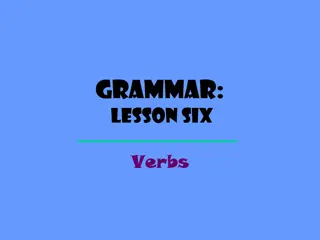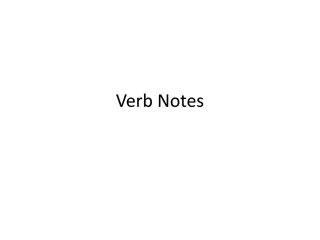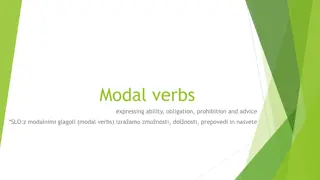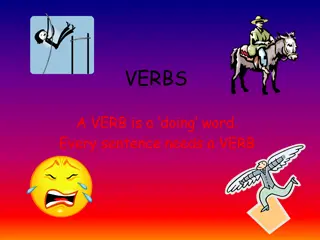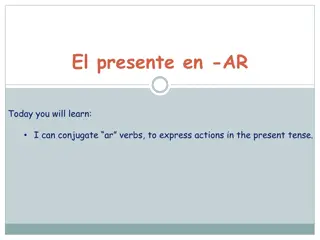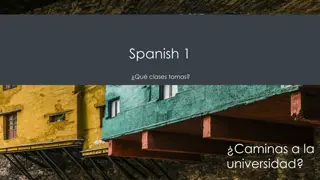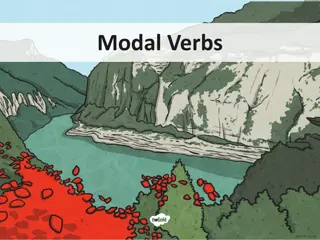Stative and Dynamic Verbs
Stative and dynamic verbs play a crucial role in understanding the change in meaning from Qal stative roots to Piel transitive roots in Hebrew grammar. Explore the distinction between stative and dynamic verbs, learn about active and passive voice, and grasp the concept of transitive verbs. Delve into the nuances of language to enhance your comprehension of verb forms and their implications.
Download Presentation

Please find below an Image/Link to download the presentation.
The content on the website is provided AS IS for your information and personal use only. It may not be sold, licensed, or shared on other websites without obtaining consent from the author.If you encounter any issues during the download, it is possible that the publisher has removed the file from their server.
You are allowed to download the files provided on this website for personal or commercial use, subject to the condition that they are used lawfully. All files are the property of their respective owners.
The content on the website is provided AS IS for your information and personal use only. It may not be sold, licensed, or shared on other websites without obtaining consent from the author.
E N D
Presentation Transcript
Rocine Lesson 33 Exodus 29:37
Goals Identify and read the change in meaning from Qal stative roots to Piel transitive roots.
What we already know Parse the first verb. Root Stem Form PGN Function Root meaning
What we already know Parse the first verb. Root Stem Form PGN Function Root meaning Hortatory Discourse Mainline To be set apart Piel Weqatal 2ms
Qal Stative versus Piel transitive In the Qal stem means be holy. In the Piel stem it means cause to be holy or simply sanctify.
What we already know Let s parse the last verb. Root Stem Form PGN Function Root meaning Hortatory Discourse Mainline To be set apart Piel Weqatal 2ms
What we already know Let s parse the last verb. Root Stem Form PGN Function Root meaning Hortatory Discourse Mainline To be set apart Piel Weqatal 2ms X-yiqtol = To be set apart Qal Yiqtol 3ms Rel. non-past background
What we already know Let s parse the last verb. Root Stem Form PGN Function Root meaning To be set apart (Piel: to set apart) Hortatory Discourse Mainline Piel Weqatal 2ms X-yiqtol = To be set apart Qal Yiqtol 3ms Rel. non-past background
Stative Rocine says There is a group of roots which have Stative rather than active meanings in the Qal stem. The use of the term active here is potentially confusing. The term dynamic might be a better choice.
Terms be, have, know, love, hate, like, doubt, seem, own, understand A stative verb is a verb that expresses a state of affairs or being rather than action. Stative eat, walk, learn, grow, sleep, talk, write, run, read, become, go Dynamic ( Active in Rocine) A verb that expresses an action. Active voice is a voice that indicates a subject has the semantic function of actor. Active Jones built the house. Passive voice is a voice that indicates that the subject is the patient or recipient of the action denoted by the verb. The house was built by Jones. Passive A transitive verb is a verb that takes a direct object. Transitive I drink coffee every day. Intransitivity is a term that describes a verb or clause that is unable to take a direct object. Intransitive I run every day. http://www-01.sil.org/linguistics/GlossaryOfLinguisticTerms/ http://www.really-learn-english.com/dynamic-verbs-and-stative-verbs.html http://web2.uvcs.uvic.ca/elc/sample/beginner/gs/gs_09.htm
ROOTS that are STATIVE in the QAL Be afraid Be full Be high, exalted Be lost Be unclean Be ashamed Be well, pleasing Be strong, firm Be complete, finished Be able Be holy Be heavy, honoured Be complete, sound Be small
ROOTS that are STATIVE in the QAL Be afraid Be full Be high, exalted Be lost Be unclean Be ashamed Be well, pleasing Be strong, firm Be complete, finished Be able Be holy Be heavy, honoured Be complete, sound Be small These verb often, but not always, have a tsere or holem theme vowel (2nd root vowel) in the Qal Qatal. E.g. , . is an example of one that doesn t.
ROOTS that are STATIVE in the QAL Be afraid Be strong, firm Be full Be complete, finished Be high, exalted Be able Be lost Be holy Be unclean Be heavy, honoured Be ashamed Be complete, sound Be well, pleasing Be small The Piel stem very often changes the meaning of these stative Qal roots into active dynamic verbs that are transitive.
ROOTS that are STATIVE in the QAL Be afraid Be strong, firm Be full Be complete, finished Be high, exalted Be able Be lost Be holy Be unclean Be heavy, honoured Be ashamed Be complete, sound Be well, pleasing Be small The above Hebrew verbs are all intransitive in Qal. Many of them become transitive in the Piel.
Stative/Intransitive in Qal -> Transitive in Piel Qal Piel Qal Piel Be afraid Terrify Be strong, firm Strengthen complete, bring to an end, finish a thing Be complete, finished Be full Fill No Piel Be high, exalted Exalt Be able Be lost Destroy Be holy Sanctify Be heavy, honoured Be unclean Defile Honour Delay (in shame) Be complete, sound Requite, restore Be ashamed Be well, pleasing No Piel Be small No Piel
Both Transitive & Intransitive Some Hebrew verbs can be either transitive or intransitive in the same binyan/stem. E.g. can mean To be afraid (stative/intransitive) To fear something (transitive) See Rocine 33.2g for examples.
Leitwort Leitwort: key words which are repeated throughout a discourse Can you find a Leitwort in this verse? How many times does it appear?
Leitwort Leitwort: key words which are repeated throughout a discourse Can you find a Leitwort in this verse? How many times does it appear?
